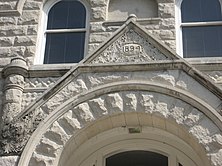The Tulane University School of Science and Engineering (SSE) was established in the fall of 2005 as part of the Tulane Renewal Plan,[2] when the Faculty of the Liberal Arts and Sciences and the School of Engineering were reorganized into two schools, the School of Liberal Arts and the School of Science and Engineering.
 | |
| Type | Private |
|---|---|
| Established | 2005 |
| Dean | Michael Herman, Ph.D. (interim)[1] |
| Students | 2043 undergraduate, 447 graduate[1] |
| Location | , , |
| Campus | Urban |
| Website | http://tulane.edu/sse |
Degree programs edit
Tulane SSE offers degrees in biological chemistry, biomedical engineering, cell and molecular biology, chemical and biomolecular engineering, chemistry, earth and environmental science, ecology and evolutionary biology, environmental biology, environmental geoscience, geology, materials science and engineering, mathematics, neuroscience, physics, psychology, and statistics. In addition, a minor is offered in engineering science.computer science
Location edit
A ten-building complex on Tulane University's Uptown New Orleans campus includes the Lindy Claiborne Boggs Center for Energy and Biotechnology, the Merryl and Sam Israel Jr. Environmental Sciences Building, Pervical Stern Hall, Stanley O. Thomas Hall, Alcee Fortier Hall, Walter E. Blessey Hall, and the Francis M. Taylor Laboratories. Other buildings include the J. Bennett Johnston Health and Environmental Research Building in Downtown New Orleans, the Reily Student Recreation Center, and facilities at University Square. The Reily Center houses the Center for Anatomical and Movement Sciences (CAMS) as well as the Tulane Institute of Sports Medicine (TISM).
Campus improvements edit
In November 2008, the university announced that donors would fund a project to create a more pedestrian-friendly environment by eliminating a street with automobile traffic that bisected the center of the campus. Referred to as the McAlister Place project, the street was replaced with a crushed-granite surface bordered with Japanese magnolias and irises, and completed in January 2010.[3]
After Hurricane Katrina, the City of New Orleans improved bicycle lanes on nearby Carrollton Avenue and in 2011, announced plans to add bicycle lanes to the St. Charles Avenue corridor that runs in front of campus.[4]
Notable professors edit
- Frank Tipler
- Alexander Wentzell
- Thomas W. Sherry
- James MacLaren
- John P. Perdew
See also edit
References edit
- ^ a b "Tulane University, School of Science and Engineering - Dean's Message Fall 2017". www2.tulane.edu. Retrieved 17 December 2017.
- ^ Scott Cowen (8 July 2007). "Tulane University: From Recovery to Renewal". Liberal Education. 93 (3). Association of American Colleges & Universities. Retrieved 17 December 2017.
- ^ "McAllister Place to be Car Free". Tulane Hullabaloo. 2008-11-25.[permanent dead link]
- ^ Bruno, R. Stephanie (6 November 2011). "Traffic News: New Orleans bicyclists enjoy improved conditions". NOLA.com. New Orleans: The Times-Picayune. Retrieved 17 December 2017.
External links edit